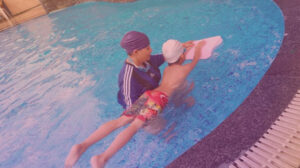LIFE WITH OSTEOPORESIS
OSTEOPORESIS
Exercise is great for just about everyone. Your heart, muscles, joints, and lungs are meant to work, whether you run ultra marathons or have a seated stretching routine. For people living with osteoporosis, exercise is particularly vital and can help in strengthen bone density. Weight-bearing, flexibility, and bone-strengthening exercises keep your bones, muscles, and joints strong. Exercise can ward off osteopenia (loss of bone density) and osteoporosis (weak, brittle bones). These two conditions disproportionately affect daily living of people.
People of any gender can develop osteoporosis, although it’s more common in women. About 30% of postmenopausal women have osteoporosis. Osteoporosis is a skeletal condition, which leads to the thinning of bones, mainly due to a deficiency of minerals such as calcium. Mineral deficiency leads to reduced bone density, which is characterized by brittle bones that are prone to fractures. Individuals with osteoporosis often experience multiple fractures in the long bones of arms and legs, and in the spine. Osteoporosis hinders movement and thus causes Joint Pain and Pain in the bones. Regular exercise and good nutrition, including getting the recommended daily amounts of calcium and vitamin D, are essential for building and maintaining bone strength throughout the lifespan. Various osteoporosis treatments and exercises have been proven to reduce fractures by 30 to 50 percent.
Role of Physiotherapy in treating Osteoporosis
Strategies to improve bone density and reduce the likelihood of falls are important in the prevention of osteoporosis. Physiotherapists have a role to play in this condition through exercise prescription, therapeutic modalities, specific techniques and education. Appropriate treatment goals can be established following a thorough assessment of signs and symptoms, risk factors for osteoporosis and functional status. Since the aim is to maximize peak bone mass in children and adolescents, participation in a variety of high-impact activities should be encouraged.
Physiotherapy includes certain bone-strengthening exercises, such as weight-bearing activities (including walking or jogging) or resistance training (such as weight lifting or yoga).To also help prevent further fractures, a physical therapist helps patients suffering from osteoporosis to improve balance and posture. Better control over balance will help people to prevent falls while proper posture takes unnecessary stress off the spine, which will reduce the risk of spinal fractures. A physical therapist may even help people to make changes in-home and/or office to promote a healthy recovery. Often physiotherapy teaches people safe ways to do everyday activities—from how to correctly lie down to how to sneeze properly—that will help people to avoid fractures. Physical therapy is an effective non-surgical treatment for osteoporosis that may help restore over all body health, healthy movement, function, and bone strength. Physiotherapy will teach patients suffering from weak bones to exercise for bone health and ways to manage daily activities to lessen the chances of having an osteoporosis-related fracture.
SOME EXERCISE FOR STRENGHTEN THE BONE HEALTH
The best bone-strengthening activities are weight-bearing exercises. Weight-bearing exercises mean those where your feet touch the ground, such as walking and jogging. These activities gently pressure the bones to encourage them to rebuild and become denser.
You can perform the following bone-strengthening exercises while standing or sitting, depending on your level of mobility functioning. For seated exercises, recommends a firm chair, like a dining room chair, not a couch.
1. Strength training
Strength-training exercises are at the heart of building bone density. When you contract and tense the muscles, they pull on the bones. This tension
“For strengthening, I believe in using light weights, even two to three pounds you don’t have to buy dumbbells to do strength training, canned goods or an eight- or 16-ounce water bottle can be your weights and this is very important that you have to gradually increase weight under the proper guidance of your physiotherapist.
- Upper body exercises: Simply lift weights with your arms, whether seated or standing. “You’re doing justice to bone resistance for the spine, vertebrae, and legs as well as the arms “If you are seated, it’s important that your feet are supported, either by the floor or wheelchair footrests.”
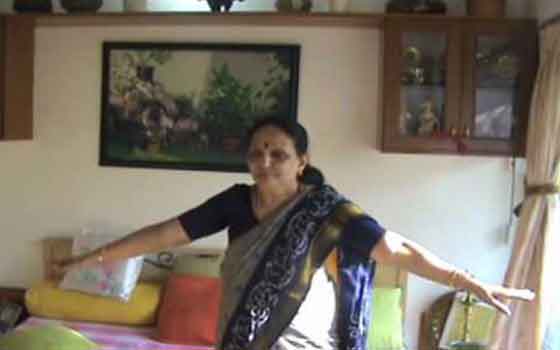
- Tension without weights: You can strengthen by firming your muscles and doing slow, intentional movements. Tensing your muscles releases chemicals that can help increase bone density. Here are a couple examples of these exercises.
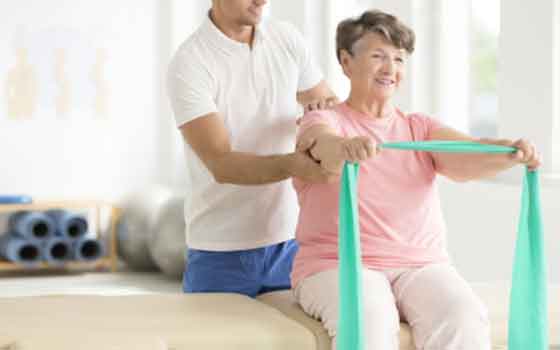
2. Resistance exercises
When you add resistance to your routine, your muscles release calcium, magnesium, and other minerals that strengthen your bones. These exercises use mechanical resistance from weight-bearing, such as resistive bands or weights.
Do three sets of 10 repetitions of these exercises, according to many studies “You’ll get the toning and a little bit of cardio.”
- Pushups: Pushups can be done in a variety of positions. Try something different from a traditional pushup.
- Standing pushups: Stand approximately 3 feet away from a wall, facing it. Place your hands shoulder-width apart at chest level against the wall. Bend your elbows as you lean into the wall. Straighten your elbows, pushing your body weight away from the wall.
- Seated pushups (adapted): Hold a lightweight pole, like a broomstick, palms down with your arms shoulder-width apart at chest level. Push the pole away from your chest, straightening your arms. Then bend your elbows, returning your arms to your chest.
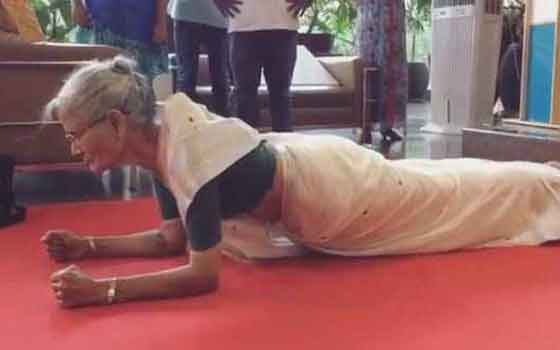
- Resistance bands: Resistance bands (like TheraBand) are a light, portable way to strengthen. They are color-coded to indicate various resistance levels. For those who are just beginning an exercise program or have joint issues, it is best to use a lighter resistance band and gradually work up to moderate and then heavier resistance bands.
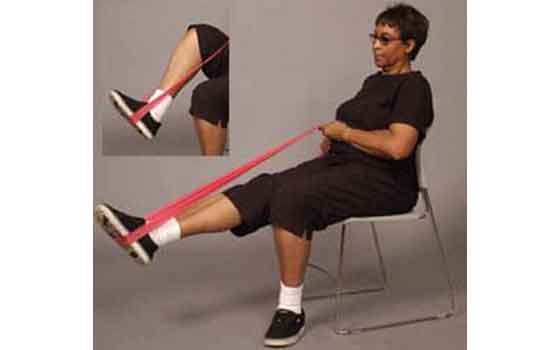
- Band pull: You can do this exercise while seated or standing. Again, if seated, it is important to support your feet on the floor or footrests. Hold onto the band approximately 5 inches away from your chest, arms shoulder-width apart. Hands are palms-down at chest level. Slowly pull the band, extending your arms beyond shoulder width. Try to straighten your arms as far as possible while creating tension in the arms. Slowly return to the beginning position, releasing the tension in your arms.
3. Balance and core exercises
Your core encompasses your stomach muscles, back muscles, and pelvic girdle. “A core workout doesn’t necessarily mean doing sit-ups. According to many studies “Everything we do engages the core.”
- One-leg stand: Stand with your hands on a counter or the back of a firm chair. Balance on one leg while lifting the other off the floor. Count to 10 while engaging your stomach muscles. Return your leg to the floor and alternate legs. Repeat several times. When you first try it, stabilize with two hands on the kitchen counter. As your core strengthens and your balance improves, you can transition to stabilizing with just one or two fingers from each hand. Eventually, you will be able to eliminate the hand.
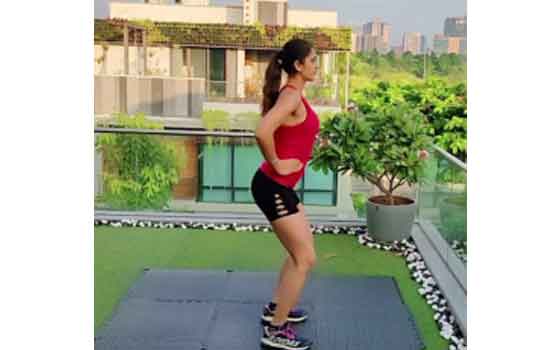
- Standing straight: Contract (hold in) your abdomen (belly), so your belly button pulls toward your spine. Stand straighter as you stabilize your core.
- Seated core: Even seated, you can build your core muscles by:
- Sitting on a firm seat, arms crossed over your chest, legs bent. Alternate raising each thigh 1 to 2 inches, engaging your core. Lower thigh to starting position.
- Sitting on a firm seat, arms crossed over your chest, straighten one knee and then return to your starting position. Alternate your legs.
4. Flexibility
Stretching is important to elongate the muscle fibers. There are many variations of stretches for the upper body and lower body, including the hamstrings and calf muscles, which can get very tight from sitting.
- Hamstring stretch: Lie on your back, a pillow under your head. Bend your knees with your feet flat on the floor or bed. Straighten one knee and raise your leg up toward the ceiling. Using both hands, grab and hold behind the thigh for 10 to 20 seconds. You may wish to interlock your fingers to better support your leg. Do not force the stretch. Lower your leg to starting position. Alternate legs and repeat. Do 3 to 5 sets.
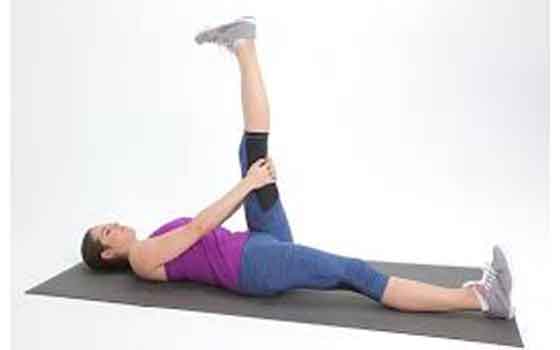
- Shoulder stretch: Standing or sitting, stretch your arms out in front of you with elbows straight. Interlock fingers. Raise both arms up toward the ceiling. Hold for 10 to 20 seconds. Slowly return to starting position. Do 3 to 5 sets.
- Calf stretch: in sitting position straight the legs and tie a band around the ankle stretch the band for 10-20 second hold or you can do in standing position by touch the toes to the wall then go forward and hold for 10-20 second hold and 10 repetitions.
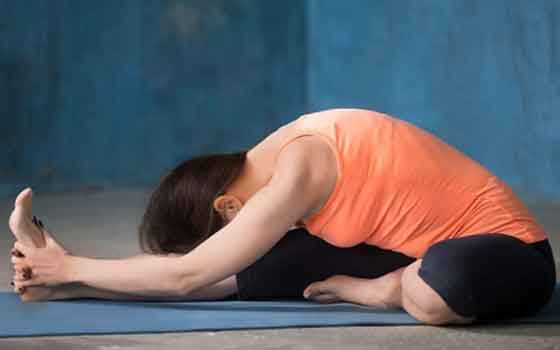
- What’s most important, Dr. Jyoti Gupta say is not to overdo it. “When stretching, only go to the point where you feel a gentle stretch, but not a forced stretch,”
5. Cardio
If you can get out of the house, a walk can offer a cardiovascular workout for your heart and lungs. If you have a gym setup available, you can exercise on the treadmill or an elliptical machine.
If you need to stay home and have no aerobic equipment available, try gentle marching in place or static cycling is the best form of exercise. Set a timer for 30 seconds or 1 minute at a time.
6. Squats
Squats can strengthen the front of your legs as well as your buttocks. You don’t have to squat deeply for this exercise to be effective.

- Start with your feet hip-width apart. Rest your hands lightly on a sturdy piece of furniture or counter for balance.
- Bend at your knees to slowly squat down. Keeps your back straight and lean slightly forward, feeling your legs working
- Squat only until your thighs are parallel to the ground.
- Tighten your buttocks to return to a standing position.
- Repeat this exercise eight to 12 times.
7. Ball sit
This exercise can promote balance and strengthen your abdominal muscles. It should be performed with a large exercise ball. You should also have someone with you to act as a “spotter” to help you maintain your balance.
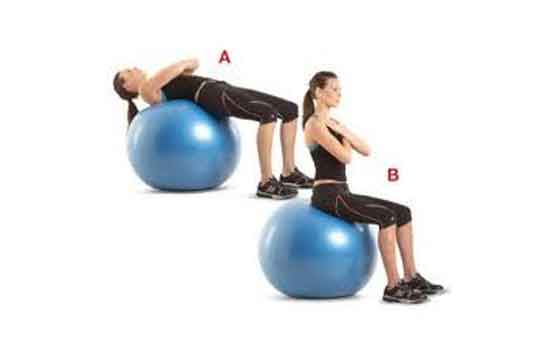
- Sit on the exercise ball with your feet flat on the floor.
- Keep your back as straight as possible while you maintain your balance.
- If you are able, hold your arms out at your sides, palms facing forward.
- Hold the position as long as one minute, if possible. Stand and rest. Repeat the exercise up to two more times.
8. Standing on one leg
This exercise promotes greater balance.
- With a sturdy piece of furniture nearby if you need to grab onto something, stand on one foot for one minute, if possible.
- Repeat the balance exercise on your other leg
TACKLE OSTEOPOROSIS WITH BEST PHYSIOTHERAPY AND REHABILITATION CENTER IN DHAKOLI.
A well qualified physiotherapist is skilled enough to help you to deal with osteoporosis. In dhakoli there is a popular physiotherapy center and its name is Blossom physiotherapy center. It’s a complete rehabilitation center with experienced doctor and ultra modular modalities. Dr.Jyoti Gupta (MPT pediatrics) that is a Pediatrics Physiotherapist as well as a certified Yoga instructor she complete her course from a well known YOGA ALLIANCE INTER NATIONAL FnY STUDIO is a head of the center and senior physiotherapist. She is having experience of more than six years in this field and her proficiency team always comes with significant results. Blossom physiotherapy provides multifunctional facilities under one roof like treatment for disease, yoga classes, exercise session, rehabilitation center etcetera. With full on covid precautions.
In osteoporosis it is become mandatory to do some form of particular exercises which only recommend by a physical therapy doctor according to patient’s ability and body strength. Without consulting an expert it may become dangerous to perform any wrong activity. So always precaution is better than cure. And for proper guidance must visit Blossom physiotherapy center where you feel positivity in the environment. For further information log into blossomphysitherapy.in

